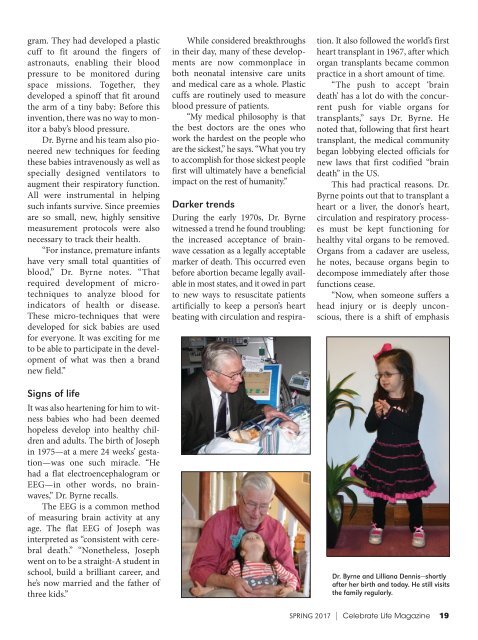Celebrate Life Magazine - Spring 2017
Celebrate Life Magazine - Spring 2017
Celebrate Life Magazine - Spring 2017
You also want an ePaper? Increase the reach of your titles
YUMPU automatically turns print PDFs into web optimized ePapers that Google loves.
gram. They had developed a plastic<br />
cuff to fit around the fingers of<br />
astronauts, enabling their blood<br />
pressure to be monitored during<br />
space missions. Together, they<br />
developed a spinoff that fit around<br />
the arm of a tiny baby: Before this<br />
invention, there was no way to monitor<br />
a baby’s blood pressure.<br />
Dr. Byrne and his team also pioneered<br />
new techniques for feeding<br />
these babies intravenously as well as<br />
specially designed ventilators to<br />
augment their respiratory function.<br />
All were instrumental in helping<br />
such infants survive. Since preemies<br />
are so small, new, highly sensitive<br />
measurement protocols were also<br />
necessary to track their health.<br />
“For instance, premature infants<br />
have very small total quantities of<br />
blood,” Dr. Byrne notes. “That<br />
required development of microtechniques<br />
to analyze blood for<br />
indicators of health or disease.<br />
These micro-techniques that were<br />
developed for sick babies are used<br />
for everyone. It was exciting for me<br />
to be able to participate in the development<br />
of what was then a brand<br />
new field.”<br />
Signs of life<br />
It was also heartening for him to witness<br />
babies who had been deemed<br />
hopeless develop into healthy children<br />
and adults. The birth of Joseph<br />
in 1975—at a mere 24 weeks’ gestation—was<br />
one such miracle. “He<br />
had a flat electroencephalogram or<br />
EEG—in other words, no brainwaves,”<br />
Dr. Byrne recalls.<br />
The EEG is a common method<br />
of measuring brain activity at any<br />
age. The flat EEG of Joseph was<br />
interpreted as “consistent with cerebral<br />
death.” “Nonetheless, Joseph<br />
went on to be a straight-A student in<br />
school, build a brilliant career, and<br />
he’s now married and the father of<br />
three kids.”<br />
While considered breakthroughs<br />
in their day, many of these developments<br />
are now commonplace in<br />
both neonatal intensive care units<br />
and medical care as a whole. Plastic<br />
cuffs are routinely used to measure<br />
blood pressure of patients.<br />
“My medical philosophy is that<br />
the best doctors are the ones who<br />
work the hardest on the people who<br />
are the sickest,” he says. “What you try<br />
to accomplish for those sickest people<br />
first will ultimately have a beneficial<br />
impact on the rest of humanity.”<br />
Darker trends<br />
During the early 1970s, Dr. Byrne<br />
witnessed a trend he found troubling:<br />
the increased acceptance of brainwave<br />
cessation as a legally acceptable<br />
marker of death. This occurred even<br />
before abortion became legally available<br />
in most states, and it owed in part<br />
to new ways to resuscitate patients<br />
artificially to keep a person’s heart<br />
beating with circulation and respira-<br />
tion. It also followed the world’s first<br />
heart transplant in 1967, after which<br />
organ transplants became common<br />
practice in a short amount of time.<br />
“The push to accept ‘brain<br />
death’ has a lot do with the concurrent<br />
push for viable organs for<br />
transplants,” says Dr. Byrne. He<br />
noted that, following that first heart<br />
transplant, the medical community<br />
began lobbying elected officials for<br />
new laws that first codified “brain<br />
death” in the US.<br />
This had practical reasons. Dr.<br />
Byrne points out that to transplant a<br />
heart or a liver, the donor’s heart,<br />
circulation and respiratory processes<br />
must be kept functioning for<br />
healthy vital organs to be removed.<br />
Organs from a cadaver are useless,<br />
he notes, because organs begin to<br />
decompose immediately after those<br />
functions cease.<br />
“Now, when someone suffers a<br />
head injury or is deeply unconscious,<br />
there is a shift of emphasis<br />
Dr. Byrne and Lilliana Dennis—shortly<br />
after her birth and today. He still visits<br />
the family regularly.<br />
SPRING <strong>2017</strong> | <strong>Celebrate</strong> <strong>Life</strong> <strong>Magazine</strong> 19





